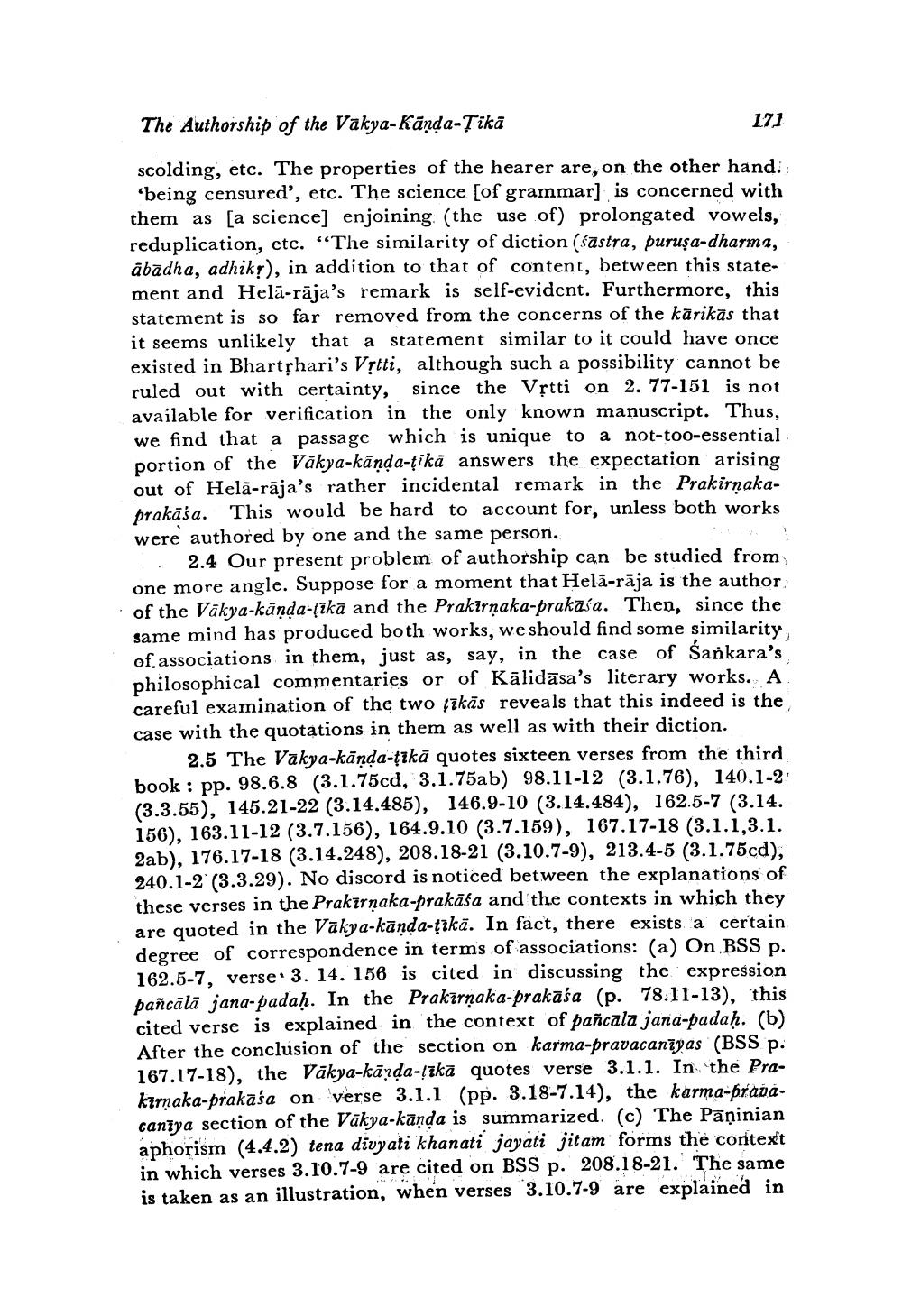Book Title: Authorship Of Vakya Kanda Tika Author(s): Ashok Aklujkar Publisher: Ashok Aklujkar View full book textPage 7
________________ The Authorship of the Vakya-Kānda-Tikā 171 scolding, etc. The properties of the hearer are, on the other hand. 'being censured', etc. The science (of grammar] is concerned with them as [a science] enjoining (the use of) prolongated vowels, reduplication, etc. “The similarity of diction (sastra, puruşa-dharma, abadha, adhikr), in addition to that of content, between this statement and Helā-rāja's remark is self-evident. Furthermore, this statement is so far removed from the concerns of the kärikäs that it seems unlikely that a statement similar to it could have once existed in Bhartshari's Vịtti, although such a possibility cannot be ruled out with certainty, since the Vștti on 2. 77-151 is not available for verification in the only known manuscript. Thus, we find that a passage which is unique to a not-too-essential portion of the Vakya-kānda-ţikā answers the expectation arising out of Helā-rāja's rather incidental remark in the Prakirnakaprakāśa. This would be hard to account for, unless both works were authored by one and the same person. 2.4 Our present problem of authorship can be studied from one more angle. Suppose for a moment that Helā-rāja is the author of the Vakya-kānda-tīkā and the Prakirņaka-prakāía. Then, since the same mind has produced both works, we should find some similarity of associations in them, just as, say, in the case of Sankara's philosophical commentaries or of Kālidāsa's literary works. A careful examination of the two ļākās reveals that this indeed is the case with the quotations in them as well as with their diction. 2.5 The Vakya-kānda-trkā quotes sixteen verses from the third book : pp. 98.6.8 (3.1.75cd, 3.1.75ab) 98.11-12 (3.1.76), 140.1-2 (3.3.55), 145.21-22 (3.14.485), 146.9-10 (3.14.484), 162.5-7 (3.14. 156), 163.11-12 (3.7.156), 164.9.10 (3.7.159), 167.17-18 (3.1.1,3.1. 2ab), 176.17-18 (3.14.248), 208.18-21 (3.10.7-9), 213.4-5 (3.1.75cd), 240.1-2 (3.3.29). No discord is noticed between the explanations of these verses in the Prakırnaka-prakāśa and the contexts in which they are quoted in the Vakya-kānda-ţikā. In fact, there exists a certain degree of correspondence in terms of associations: (a) On BSS p. 162.5-7, verse. 3. 14. 156 is cited in discussing the expression pañcālā jana-padaḥ. In the Prakirnaka-prakaśa (p. 78.11-13), this cited verse is explained in the context of pañcala jana-padaḥ. (b) After the conclusion of the section on karma-pravacanīyas (BSS p. 167.17-18), the Vākya-kānda-!īkā quotes verse 3.1.1. In the Prakırnaka-prakasa on verse 3.1.1 (pp. 3.18-7.14), the karma-pravacanīya section of the Vakya-kanda is summarized. (c) The Pāṇinian aphorism (4.4.2) tena divyati khanati jayati jitam forms the context in which verses 3.10.7-9 are cited on BSS p. 208.18-21. The same is taken as an illustration, when verses 3.10.7-9 are explained inPage Navigation
1 ... 5 6 7 8 9 10 11 12 13 14 15 16 17 18 19 20 21 22 23 24
